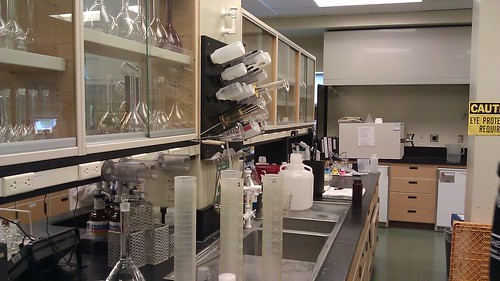
 )
)It’s been a few weeks since we’ve discussed the COVID-19 pandemic, so it seems like we should touch base there. Having disrupted the exponential growth of cases (at least for now), thoughts are turning towards how to move forward. The burden of staying at home is substantial and not equally distributed, so wanting to get out again is understandable. At the same time, with most of the population still unexposed and thus susceptible and a vaccine still along ways off, the mitigation of spread is still highly contingent on measures like social distancing, sheltering in place, and voluntary self-quarantine. Any contemplation of resuming interrupted activities requires careful consideration of how reduce the risk of transmission. For research institutions and scientists like many of you, that includes figuring out how to make laboratories safer.
Laboratory scientists already face biological, chemical, or radiological exposure risks; many labs deal with all three. So they receive training and personal protective equipment and follow a variety of safety protocols. Not to mention the protocols and equipment needed in some cases to keep the experiments safe from contamination. But the one thing I don’t remember ever even contemplating, let alone getting trained for, was risk from fellow scientists. On the contrary, science is collaborative and so labs are often designed to maximize contact with other scientists even as they try to minimize contact with everything else. And sometimes, with space needed for equipment and sample storage and everything else, the people parts may be minimal. I’ve shared many a meal with several colleagues around a small table flanked by students on computers or reading journals in a multipurpose space.
If you run or work in a lab, I imagine you have already considered these issues and may be well on your way to mitigation plans. Or perhaps you’ve already had to solve these problems to carry out coronavirus-related research. The rest of you may be interested in this discussion of some of the challenges and potential solutions. There are the largely physical issues I’ve alluded to, as well as administrative and educational factors to consider. And then there are students and researchers whose continued presence in this country may hinge on being able to work. I expect many of these will have analogues in other departments and places of employment, if not direct connections.
Changing gears more than slightly, another topic on many minds is the proliferation of compelling yet methodologically flawed alternative interpretations of the facts of our current situation. I am inclined to apply an adage I picked up from author Si Spurrier: factions speak louder than herds. Toss in a dash of the squeaky wheel getting greased and suddenly the majority of us are obligated to pay attention to the misguided musings of a few. I’d prefer not to engage at all, but the observed correlation to Christianity (which needs to be understood in the context of the confounding variable of right wing politics) means it merits at least a mention. If you need it, I recommend this resource for fact checking on the popular conspiracy video making the rounds. And if you want some wider perspective on the theological and sociological connections, I couldn’t do better than this piece from BioLogos. They are also having a livestream conversation next week with New York City pastor Tim Keller and NIH Director Francis Collins, a great opportunity to ask a question of and hear from two folks deeply involved in our present challenge.
Andy has worn many hats in his life. He knows this is a dreadfully clichéd notion, but since it is also literally true he uses it anyway. Among his current metaphorical hats: husband of one wife, father of two teenagers, reader of science fiction and science fact, enthusiast of contemporary symphonic music, and chief science officer. Previous metaphorical hats include: comp bio postdoc, molecular biology grad student, InterVarsity chapter president (that one came with a literal hat), music store clerk, house painter, and mosquito trapper. Among his more unique literal hats: British bobby, captain’s hats (of varying levels of authenticity) of several specific vessels, a deerstalker from 221B Baker St, and a railroad engineer’s cap. His monthly Science in Review is drawn from his weekly Science Corner posts — Wednesdays, 8am (Eastern) on the Emerging Scholars Network Blog. His book Faith across the Multiverse is available from Hendrickson.

I’m wondering what is the exact date of the discussion for the live stream? It means the discussion will be start this week right?